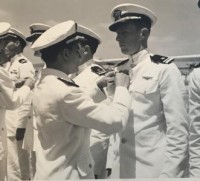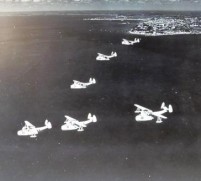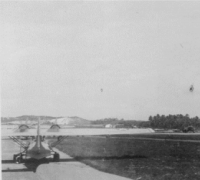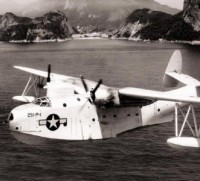U.S. NAVY VP SQUADRONS IN BRAZIL - THE TIMES OF RICHARD ARNOLD AT VP 94
3)TWIN ENGINE DRILL AT CORPUS CHRISTI
We reported to Corpus Christi early in April to begin training in larger, more powerful aircraft. We would have basic, instrument, and advanced training leading up to graduation, receiving our wings and our commission as Ensigns in the Navy or Second Lieutenant in the Marine Corps. We had a lot of ground school along with our flight training. The courses were in navigation, gunnery, aerology, and various courses on Navy indoctrination. The Navy had a few navigators, but for the most part, Navy pilots had to do their own navigating. All carrier pilots had to know how to navigate on a plotting board which slid under the instrument panel and was out of the way while you were maneuvering.
It was all dead-reckoning of course. You would plot in the current wind direction and velocity and then plot your headings. time on course, and air speed and with any luck, be fairly accurate in your position at any given time. The carrier did have radio signals which they emitted to assist the pilots in locating their home base. We had no idea what type of plane we would fly if we ever got to the fleet, so we all had to know navigation. The aircraft we flew in our first phase of training at Corpus were Vultee trainers. They were all metal low wing planes with fixed landing gear. They looked like a poor man’s SNJ, not as streamlined or powerful.
They had two seats, fore and aft, a fixed pitch prop, and all plexiglass canopy. Cadets called them Vultee “Vibrators” We went through many of the same things we had gone through in N3N’s learning how to just fly the airplane. After we had become fairly proficient with the airplane we went into the next phase of instruction which was instrument training. Here we were taught how to control the airplane in bad weather when there was zero visibility. We had to learn to rely strictly on our instruments to determine the attitude of the airplane as well as where we were with respect to the ground. We were put under a hood so that we would not see out. The instructor would then put the airplane in unusual attitudes and turn it over to the student. He was expected to straighten it out strictly with the use of the instruments.
This was where I met my hot rock instructor. I had a Lt. (j.g.) named Johnson (probably a relative) who would do violent maneuvers while I was under the hood. He would do a maneuver called a cartwheel where the plane was put into a steep turn in one direction, then he would kick top rudder and the plane would flip over the top to a steep turn the other way. The centrifugal force would pull you down in the seat and your jaws would be down in your lap. He would turn the plane over to you in the middle of the maneuvers. The wings would pop like an oil can and scare the hell out of you. The other he did was to pull the plane straight up til the airspeed dropped to zero, then give it to you. These were extreme maneuvers and in one instance caused one of my instruments to fail and I couldn’t recover from the unusual position.
He raised hell with me and didn’t believe that the instrument was faulty. I made him look into the rear cockpit and confirm it. We had a short discussion about hot pilots and I told him I had no intention of being killed by an idiot (he had entered the landing pattern doing tail slides) and that I was going directly to flight operations and request a different instructor. I did that and it probably saved my Navy career. I later saw my write-up from him wllich said I had developed a “belligerent” attitude toward my instructor. I still have my student flight record which shows it. They apparently were not unaware of his problems because the next day I had a new instrnctor. He told me in our first flight together that I was doing satisfactory work.
We also learned at this time in our training how to fly a radio range which helped you to locate an airport in bad weather. The station which was located a mile or so from the airport would emit a directional signal wllich you turned in on a given frequency. When you were on the beam you heard a high pitched steady tone. If you got off to either side of the beam you would begin to get the Morse code signal for an A(dot dash) or an N(dash dot). Depending on which one you got, you knew which side of the beam you were on and would adjust your heading accordingly. That was called bracketing the beam. When you were directly over the station the signal faded out and you were in the cone of silencee. That told you that you had just passed over the station. At that point, you turned to a predetermined heading for a minute and fifteen seconds or so, started a procedure turn and a let down, wllich got you back on an inbound heading toward the field.
You would hit the cone of silence again at a nlinimum altitude and turn to a heading for the field. With any luck, as you let down to the nlinimum allowable attitude, you would see the field and be lined up with the runway. Everything was timed and if the field wasn’t there, you executed what was called a missed approach procedure, climbing back up and either doing it over or going to an alternate airport. This all sounds fairly routine and simple, but you could be in a thunderstorm or fog clear to the ground, so it wasn’t quite as easy as it sounds. At the same time that we were doing it in the air, we were taking a course on the ground in a Link Trainer. This was a box made up exactly like the cockpit of an airplane with all the controls and instruments in an airplane.
The radios worked just like an airplane and a stylus on wheels, which was called a, kept track of all of your changes in direction, altitude airspeed, and position with relation to the station if you were doing a radio problem. Between the air work and the hours spent in the Link, we achieved a small degree of proficiency. While I was in that phase of training, I had a roommate that again kept things light and relaxed. His name was Walter Douglas Storey or Dub for short. Dub was sort of stocky, short and bald. He had a great sense of humor and there was no way to ever feel down when Dub was around. We were separated when we both went to final squadron. Dub went into observation planes, 0S2Us, but before that, he was sent to New Orleans to instruct. He didn’t like that and did something to get sent to the fleet.
I heard that he was assigned to the Indianapolis which was sunk with great loss of life, but I was never ble to find out if it was true. I attempted to find him through the Bureau of Naval Personnel but was unable to do so. The next and last phase of our training was advanced or final squadron. I had made my choice to remain a Navy pilot rather than switch to the Marine Corps. Most of us had put fighters as our first choice, but the Navy had decided that they would start some B-25 squadrons and had an advanced program called land based bombers. It sounded pretty good and if you did want to get into commercial aviation, it gave you some multi-engine experience. After the Tokyo raid, B-25s were pretty exciting.
The Navy designation was PBJ, P for patrol, B for bomber, J for North American Aircraft Company. So I put in for land based bombers and was sent to Cabiness Field in early June to begin my last phase before graduation. When we changed fields, we also got a new roommate and in this case a partner to fly our new airplane with. Don Clark was my new partner and we got along well. We had already ordered our officer’s uniforms. They had to be tailormade and in those days cost a lot of money. We got dress blues, dress khakis, and aviator greens. In addition, we had khaki work uniforms, several of those. We would be in hock forever if we flunked out now. By this time, we were pretty sure we would make it.
Besides the Navy had a lot of money invested in us so our chances of making it were pretty good. The airplanes we would fly were designated SNB or JRB. In civilian life they were D-18 Beechcraft with two 450 horsepower engines. When we first looked into the cockpit and saw all those instruments we thought it was all over - we would never master all those gadgets. With two engines we had two of eveiything plus all of the flight instruments. It was really a nice little airplane and fairly fast - about 180 mph. It had twin rudders which were blanked out by the wing when the tail was on the ground. That was when you started a take-off or finished a landing so it was a little hard to control at those two times. In addition, at the main base we had short runways because we used the first half for landings and the last half for take-offs.
The runways were only 3000 feet long which meant we had to land on the first 1500 feet. So again, we had to make a typical Navy landing - very short. Again we had to learn all about the airplane, its flight characteristics, control systems, electrical system, etc. In addition, we now had to learn how to control a two engine airplane when one engine was inoperative. The instructors would simulate engine failure by just pulling back one of the throttles. It could be on take off or landing or just cruising at altitude. There was a set routine when an engine was feathered. The plane had to be trimmed to fly straight with all the pull on one side, trim tabs set to help the pilot do that, then feather the dead engine, put the mixture control in idle cutoff, turn off the fuel selector and the switch.
Then the landing was a little more difficult. All of these were practiced. Don Clark was not a particularly good pilot. We would go up for a checkride and one of us would sit in the back while the other was checked, then we would switch. On our final check, I had completed mine and Don moved up in the left seat for his. It was fairly routine until on final approach the instructor cut an engine. Don looked over at him, gave him a dirty look and pushed the throttle back up. The instructor reached up and cut it again. Don gave him another dirty look and pushed it up again. The instructor looked back at me and shrugged and just let it go. At the end of the flight, he told Don not to land at the main base on the short runways, to let me do it.
There were also a number of the Beechcrafts that were configured like a bomber with a plexiglass nose and a bombsight. They also had a fully operational 30 calibre machine gun in a turret which we learned to operate. The completion of advanced training was the end of flight training for us and we were transferred back to the main station after our last flight on July 16, 1943, to wait for graduation. Five days later, July 21, 177 of us received our wings and designation as Naval Aviators from Rear Admiral C. P. Mason. We were now considered officers and gentlemen, a bit of a stretch for most of us. As we broke formation in our new officers’s whites, we found some enlisted men anxiously waiting to give us our first salute. Actually they weren’t that excited for us, tradition said I,ve had to give the first one to salute us a dollar. Those graduations happened twice a week so there was about $350 for them to pick up.
This was happening twice a week in both Corpus and Pensacola so the Navy was turning out around 700 new Navy and Marine pilots every week. The war was a year-and-a-half old and we still had some operational training to go through before we were ready to join fleet units. Bruce had graduated a few days before and was ordered to operational training in torpedo bombers, TBMs, in Ft. Lauderdale, Florida. Dave had been sent to Coral Gables, Florida, to join a YR squadron flying seaplane transports. Don and I were ordered to navigation and gunnery school at Hollywood, Florida. Bruce, Dave and I were lined up down the Florida coast, so that section of the country was safe. Dave, of course, had rented a two story house and told me his guest room was my room whenever I could get there. Bruce had married his girl friend, Teeky O’Hara, and had a small home on the beach. He wanted me to come up there too, so I had places to go on liberty.
The problem was, nobody had a car, and if you had one, gasoline was rationed so you couldn’t go very far anyway. Anyplace we went, we generally hitchhiked or took buses if we could. It was a tough war! Don and I were stationed at the Hollywood Beach Hotel which had been taken over by the Navy for use as a school. We had a suite of rooms with about six of us in the suite. One of them was a great young guy named Bob Malecki who had gone through PBYs in advanced training. Here again we took courses in dead reckoning and celestial navigation. We learned how to determine our position by shooting sun lines and star shots. We had to learn the positions of all the stars we could use in navigating over the ocean where we had no radio aids to assist us. We had a number of night flights in Beechcraft airplanes fitted with navigation desks and celestial domes to shoot star shots.
They were usually midnight take-offs with the flight several hours long up the coast. One night we were scheduled for a midnight takeoff so about 10:00 P.M Don, Bob, Fred Stalder, who lived across the hall, and I went out for a snack before our flight. There must have been one or two more because three of them were smoking. They lit three on the same match which was supposed to be bad luck. They said that was nonsense. We finished our snacks and headed for the flight line. There had been a shakeup in the schedule and several of us had been changed from one plane to another. I was one, Bob and Fred were two more. Around midnight, the planes lined up for takeoff. Several had gotten off before we were cleared and as we reached about 3000 feet, we saw a flash directly ahead of us. It looked like a cumulus cloud lighting up in a thunder storm.
Our pilot got all shook up, called the tower and reported that one of our planes had exploded. All planes were immediately recalled. Some had gotten pretty far up the coast so it was some time before all the planes could be contacted and return to base. We made a very shaky landing, then we all went in to the operations area to wait and see which plane it was. When everybody had returned we found that it was our roommate, Bob Malecki, and Fred Stalder plus some others I did not know. We went back to our rooms about 5:00 AM. Later when the wreckage was located, one of our roommates was asked to come and try to identify the remains. The remains were just parts and I remember how sick he was when he got back. Strangely, I don’t even remember who he was. By now, we had lost enough friends, plus knowing about several others, and we knew it could happen to any of us.
Naturally everything went on just as before. In addition to navigation, we had courses in aerology. We learned about the different types of weather fronts, cold fronts, warm fronts, occluded fronts, and the types of weather and clouds associated with each. We learned what we could fly into and what we should avoid if possible. Of course when we started flying operational patrols, we flew through all of them. Even then, we avoided the rougher ones when we could. We also had gunnery classes and learned to shoot our sidearms as well as learning to shoot skeet and trap That taught us to lead a target, shoot in front of it when it is crossing your course. These were called partial and full deflection shots. I did get so that I was able to hit twenty-three or twenty-four out of twenty-five clay birds in skeet and trap.
We had some Beech aircraft with the turrets in them and learned to use them, firing at target towed by other aircraft. Or we would go out over the water, fly low and fire at white caps or targets on the water. This was where Don pulled another of his patented foul-ups. The instructor was flying the aircraft and we were taking our turns firing the machine gun. He would fly up the beach and tell us to fire out toward the open sea so as not to risk hitting anyone on land. I had finished my turn in the turret and switched places with Don. The instructor was flying north up the coast, told Don to aim out to sea and open fire. We were at 200 feet or so and looked out the right side of the plane to watch the bullets hit the water. We heard him firing but couldn’t see where his shells were going.
The instructor looked back and saw the turret aimed at the beach. He let out a few cuss words, told Don again to shoot away from the beach and put the plane in a big turn. As he turned the plane Don turned the turret and as we straightened out opened fire again. Of course, he was shooting at the beach again. That was the end of that flight and almost of the instructor. We were there about six weeks as l recall, had a few days leave and received our orders to ComAirLant (Commander Air Force Atlantic Fleet) in Norfolk, Virginia. Everybody knew what was going on in the Pacific. There had been some decisive victories starting with the Battle of Midway which had changed the course of the war. The Pacific war was pretty much a Navy war. We had all expected to go there. Very few people knew much about the Battle of the Atlantic, including us.
The Battle of the Atlantic was pretty much a submarine war. Thousands of American troops were going to Europe for the coming invasion, as well as material, fuel, ammunition, etc. Large convoys were going down the east coast of South America across the south Atlantic and up to England. The German submarines and blockade runners were trying to stop as many of them as they could so there was some work for Navy patrol squadrons. Early in the war, Germany had wolfpacks of submarines attempting to disrupt the convoys.
Cont.



